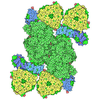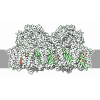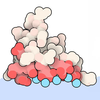+ Open data
Open data
- Basic information
Basic information
| Entry | Database: PDB / ID: 8gn2 | |||||||||
|---|---|---|---|---|---|---|---|---|---|---|
| Title | Crystal structure of PPBQ-bound photosystem II complex | |||||||||
 Components Components |
| |||||||||
 Keywords Keywords | PHOTOSYNTHESIS / Photosystem / electron transfer / electron acceptor / Quinone | |||||||||
| Function / homology |  Function and homology information Function and homology informationphotosystem II oxygen evolving complex / photosystem II assembly / oxygen evolving activity / photosystem II stabilization / photosystem II reaction center / photosystem II / oxidoreductase activity, acting on diphenols and related substances as donors, oxygen as acceptor / photosynthetic electron transport chain / photosystem II / response to herbicide ...photosystem II oxygen evolving complex / photosystem II assembly / oxygen evolving activity / photosystem II stabilization / photosystem II reaction center / photosystem II / oxidoreductase activity, acting on diphenols and related substances as donors, oxygen as acceptor / photosynthetic electron transport chain / photosystem II / response to herbicide / extrinsic component of membrane / chlorophyll binding / plasma membrane-derived thylakoid membrane / photosynthetic electron transport in photosystem II / photosynthesis, light reaction / phosphate ion binding / : / photosynthesis / respiratory electron transport chain / manganese ion binding / electron transfer activity / protein stabilization / iron ion binding / heme binding / metal ion binding Similarity search - Function | |||||||||
| Biological species |  Thermostichus vulcanus (bacteria) Thermostichus vulcanus (bacteria) | |||||||||
| Method |  X-RAY DIFFRACTION / X-RAY DIFFRACTION /  SYNCHROTRON / SYNCHROTRON /  MOLECULAR REPLACEMENT / Resolution: 1.95 Å MOLECULAR REPLACEMENT / Resolution: 1.95 Å | |||||||||
 Authors Authors | Kamada, S. / Nakajima, Y. / Shen, J.-R. | |||||||||
| Funding support |  Japan, 1items Japan, 1items
| |||||||||
 Citation Citation |  Journal: J.Biol.Chem. / Year: 2023 Journal: J.Biol.Chem. / Year: 2023Title: Structural insights into the action mechanisms of artificial electron acceptors in photosystem II. Authors: Kamada, S. / Nakajima, Y. / Shen, J.R. | |||||||||
| History |
|
- Structure visualization
Structure visualization
| Structure viewer | Molecule:  Molmil Molmil Jmol/JSmol Jmol/JSmol |
|---|
- Downloads & links
Downloads & links
- Download
Download
| PDBx/mmCIF format |  8gn2.cif.gz 8gn2.cif.gz | 3.2 MB | Display |  PDBx/mmCIF format PDBx/mmCIF format |
|---|---|---|---|---|
| PDB format |  pdb8gn2.ent.gz pdb8gn2.ent.gz | 2.2 MB | Display |  PDB format PDB format |
| PDBx/mmJSON format |  8gn2.json.gz 8gn2.json.gz | Tree view |  PDBx/mmJSON format PDBx/mmJSON format | |
| Others |  Other downloads Other downloads |
-Validation report
| Summary document |  8gn2_validation.pdf.gz 8gn2_validation.pdf.gz | 38 MB | Display |  wwPDB validaton report wwPDB validaton report |
|---|---|---|---|---|
| Full document |  8gn2_full_validation.pdf.gz 8gn2_full_validation.pdf.gz | 38.6 MB | Display | |
| Data in XML |  8gn2_validation.xml.gz 8gn2_validation.xml.gz | 345.7 KB | Display | |
| Data in CIF |  8gn2_validation.cif.gz 8gn2_validation.cif.gz | 425.3 KB | Display | |
| Arichive directory |  https://data.pdbj.org/pub/pdb/validation_reports/gn/8gn2 https://data.pdbj.org/pub/pdb/validation_reports/gn/8gn2 ftp://data.pdbj.org/pub/pdb/validation_reports/gn/8gn2 ftp://data.pdbj.org/pub/pdb/validation_reports/gn/8gn2 | HTTPS FTP |
-Related structure data
| Related structure data |  8gn0C  8gn1C 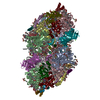 3wu2S S: Starting model for refinement C: citing same article ( |
|---|---|
| Similar structure data | Similarity search - Function & homology  F&H Search F&H Search |
- Links
Links
- Assembly
Assembly
| Deposited unit | 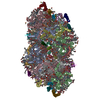
| ||||||||||||
|---|---|---|---|---|---|---|---|---|---|---|---|---|---|
| 1 |
| ||||||||||||
| Unit cell |
|
- Components
Components
-Photosystem II ... , 17 types, 33 molecules AaBbCcDdHhIiJjKkLlMmOoTtUuYyXx...
| #1: Protein | Mass: 38235.602 Da / Num. of mol.: 2 / Source method: isolated from a natural source / Source: (natural)  Thermostichus vulcanus (bacteria) / References: UniProt: P51765, photosystem II Thermostichus vulcanus (bacteria) / References: UniProt: P51765, photosystem II#2: Protein | Mass: 56068.742 Da / Num. of mol.: 2 / Source method: isolated from a natural source / Source: (natural)  Thermostichus vulcanus (bacteria) / References: UniProt: D0VWR1 Thermostichus vulcanus (bacteria) / References: UniProt: D0VWR1#3: Protein | Mass: 49668.758 Da / Num. of mol.: 2 / Source method: isolated from a natural source / Source: (natural)  Thermostichus vulcanus (bacteria) / References: UniProt: D0VWR7 Thermostichus vulcanus (bacteria) / References: UniProt: D0VWR7#4: Protein | Mass: 38419.941 Da / Num. of mol.: 2 / Source method: isolated from a natural source / Source: (natural)  Thermostichus vulcanus (bacteria) / References: UniProt: D0VWR8, photosystem II Thermostichus vulcanus (bacteria) / References: UniProt: D0VWR8, photosystem II#7: Protein | Mass: 7057.349 Da / Num. of mol.: 2 / Source method: isolated from a natural source / Source: (natural)  Thermostichus vulcanus (bacteria) / References: UniProt: P19052 Thermostichus vulcanus (bacteria) / References: UniProt: P19052#8: Protein/peptide | Mass: 4438.255 Da / Num. of mol.: 2 / Source method: isolated from a natural source / Source: (natural)  Thermostichus vulcanus (bacteria) / References: UniProt: P12240 Thermostichus vulcanus (bacteria) / References: UniProt: P12240#9: Protein/peptide | Mass: 4105.908 Da / Num. of mol.: 2 / Source method: isolated from a natural source / Source: (natural)  Thermostichus vulcanus (bacteria) / References: UniProt: Q7DGD4 Thermostichus vulcanus (bacteria) / References: UniProt: Q7DGD4#10: Protein/peptide | Mass: 4101.911 Da / Num. of mol.: 2 / Source method: isolated from a natural source / Source: (natural)  Thermostichus vulcanus (bacteria) / References: UniProt: P19054 Thermostichus vulcanus (bacteria) / References: UniProt: P19054#11: Protein/peptide | Mass: 4299.044 Da / Num. of mol.: 2 / Source method: isolated from a natural source / Source: (natural)  Thermostichus vulcanus (bacteria) / References: UniProt: P12241 Thermostichus vulcanus (bacteria) / References: UniProt: P12241#12: Protein/peptide | Mass: 4009.682 Da / Num. of mol.: 2 / Source method: isolated from a natural source / Source: (natural)  Thermostichus vulcanus (bacteria) / References: UniProt: P12312 Thermostichus vulcanus (bacteria) / References: UniProt: P12312#13: Protein | Mass: 26651.707 Da / Num. of mol.: 2 / Source method: isolated from a natural source / Source: (natural)  Thermostichus vulcanus (bacteria) / References: UniProt: D0VWR2 Thermostichus vulcanus (bacteria) / References: UniProt: D0VWR2#14: Protein/peptide | Mass: 3906.738 Da / Num. of mol.: 2 / Source method: isolated from a natural source / Source: (natural)  Thermostichus vulcanus (bacteria) / References: UniProt: P12313 Thermostichus vulcanus (bacteria) / References: UniProt: P12313#15: Protein | Mass: 11655.986 Da / Num. of mol.: 2 / Source method: isolated from a natural source / Source: (natural)  Thermostichus vulcanus (bacteria) / References: UniProt: P56152 Thermostichus vulcanus (bacteria) / References: UniProt: P56152#17: Protein/peptide | Mass: 3228.035 Da / Num. of mol.: 2 / Source method: isolated from a natural source / Source: (natural)  Thermostichus vulcanus (bacteria) / References: UniProt: D0VWR3 Thermostichus vulcanus (bacteria) / References: UniProt: D0VWR3#18: Protein/peptide | Mass: 4191.030 Da / Num. of mol.: 2 / Source method: isolated from a natural source / Source: (natural)  Thermostichus vulcanus (bacteria) / References: UniProt: D0VWR4 Thermostichus vulcanus (bacteria) / References: UniProt: D0VWR4#19: Protein | Mass: 6794.197 Da / Num. of mol.: 2 / Source method: isolated from a natural source / Source: (natural)  Thermostichus vulcanus (bacteria) / References: UniProt: D0VWR5 Thermostichus vulcanus (bacteria) / References: UniProt: D0VWR5#20: Protein/peptide | | Mass: 4590.648 Da / Num. of mol.: 1 / Source method: isolated from a natural source / Source: (natural)  Thermostichus vulcanus (bacteria) / Strain: NIES-2133 / IAM M-273 / BP-1 / References: UniProt: Q8DKM3 Thermostichus vulcanus (bacteria) / Strain: NIES-2133 / IAM M-273 / BP-1 / References: UniProt: Q8DKM3 |
|---|
-Cytochrome b559 subunit ... , 2 types, 4 molecules EeFf
| #5: Protein | Mass: 9449.645 Da / Num. of mol.: 2 / Source method: isolated from a natural source / Source: (natural)  Thermostichus vulcanus (bacteria) / References: UniProt: P12238 Thermostichus vulcanus (bacteria) / References: UniProt: P12238#6: Protein/peptide | Mass: 4936.704 Da / Num. of mol.: 2 / Source method: isolated from a natural source / Source: (natural)  Thermostichus vulcanus (bacteria) / References: UniProt: P12239 Thermostichus vulcanus (bacteria) / References: UniProt: P12239 |
|---|
-Protein , 1 types, 2 molecules Vv
| #16: Protein | Mass: 15148.255 Da / Num. of mol.: 2 / Source method: isolated from a natural source / Source: (natural)  Thermostichus vulcanus (bacteria) / References: UniProt: P0A387 Thermostichus vulcanus (bacteria) / References: UniProt: P0A387 |
|---|
-Sugars , 3 types, 47 molecules 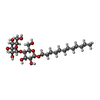
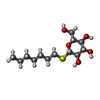
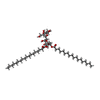


| #29: Sugar | ChemComp-LMT / #36: Sugar | ChemComp-HTG / #39: Sugar | ChemComp-DGD / |
|---|
+Non-polymers , 21 types, 3526 molecules 


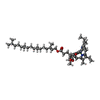

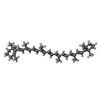
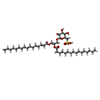
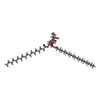

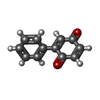
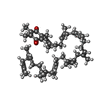
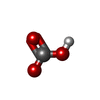

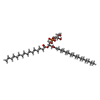
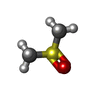
























-Details
| Has ligand of interest | Y |
|---|---|
| Has protein modification | Y |
| Sequence details | SEQUENCE ABOUT PRO A(A) 279, LEU K(K) 33, TRP K(K) 39 AND LEU M(M) 8, THE AUTHOR CONFIRMED BY ...SEQUENCE ABOUT PRO A(A) 279, LEU K(K) 33, TRP K(K) 39 AND LEU M(M) 8, THE AUTHOR CONFIRMED BY ELECTRON DENSITY MAP. THESE RESIDUES OF CHAIN C(C) ARE BASED ON THE DATABASE SEQUENCE FROM THERMOSYNE |
-Experimental details
-Experiment
| Experiment | Method:  X-RAY DIFFRACTION / Number of used crystals: 1 X-RAY DIFFRACTION / Number of used crystals: 1 |
|---|
- Sample preparation
Sample preparation
| Crystal | Density Matthews: 3.33 Å3/Da / Density % sol: 63.1 % |
|---|---|
| Crystal grow | Temperature: 285 K / Method: microbatch / pH: 6.1 Details: 5% PEG1450, 20mM NaCl, 10mM CaCl2, 40mM MgSO4, 20mM MES buffer, pH 6.1, MICRO-BATCH METHOD UNDER OIL, temperature 285K |
-Data collection
| Diffraction | Mean temperature: 100 K / Serial crystal experiment: N |
|---|---|
| Diffraction source | Source:  SYNCHROTRON / Site: SYNCHROTRON / Site:  SPring-8 SPring-8  / Beamline: BL41XU / Wavelength: 1 Å / Beamline: BL41XU / Wavelength: 1 Å |
| Detector | Type: RAYONIX MX225HE / Detector: CCD / Date: Apr 13, 2021 |
| Radiation | Monochromator: M / Protocol: SINGLE WAVELENGTH / Monochromatic (M) / Laue (L): M / Scattering type: x-ray |
| Radiation wavelength | Wavelength: 1 Å / Relative weight: 1 |
| Reflection | Resolution: 1.95→50 Å / Num. obs: 583631 / % possible obs: 98.7 % / Redundancy: 7 % / Biso Wilson estimate: 37.38 Å2 / CC1/2: 1 / Rmerge(I) obs: 0.061 / Net I/σ(I): 18.6 |
| Reflection shell | Resolution: 1.95→2.02 Å / Redundancy: 7 % / Rmerge(I) obs: 1.465 / Mean I/σ(I) obs: 1.4 / Num. unique obs: 57320 / CC1/2: 0.704 / % possible all: 97.6 |
- Processing
Processing
| Software |
| |||||||||||||||||||||||||||||||||||||||||||||||||||||||||||||||||||||||||||||||||||||||||||||||||||||||||||||||||||||||||||||||||||||||||||||||||||||||||||||||||||||||||||||||||||||||||||||||||||||||||||||||||||||||||
|---|---|---|---|---|---|---|---|---|---|---|---|---|---|---|---|---|---|---|---|---|---|---|---|---|---|---|---|---|---|---|---|---|---|---|---|---|---|---|---|---|---|---|---|---|---|---|---|---|---|---|---|---|---|---|---|---|---|---|---|---|---|---|---|---|---|---|---|---|---|---|---|---|---|---|---|---|---|---|---|---|---|---|---|---|---|---|---|---|---|---|---|---|---|---|---|---|---|---|---|---|---|---|---|---|---|---|---|---|---|---|---|---|---|---|---|---|---|---|---|---|---|---|---|---|---|---|---|---|---|---|---|---|---|---|---|---|---|---|---|---|---|---|---|---|---|---|---|---|---|---|---|---|---|---|---|---|---|---|---|---|---|---|---|---|---|---|---|---|---|---|---|---|---|---|---|---|---|---|---|---|---|---|---|---|---|---|---|---|---|---|---|---|---|---|---|---|---|---|---|---|---|---|---|---|---|---|---|---|---|---|---|---|---|---|---|---|---|---|
| Refinement | Method to determine structure:  MOLECULAR REPLACEMENT MOLECULAR REPLACEMENTStarting model: 3wu2 Resolution: 1.95→49.22 Å / SU ML: 0.2101 / Cross valid method: FREE R-VALUE / σ(F): 1.34 / Phase error: 22.5739 Stereochemistry target values: GeoStd + Monomer Library + CDL v1.2
| |||||||||||||||||||||||||||||||||||||||||||||||||||||||||||||||||||||||||||||||||||||||||||||||||||||||||||||||||||||||||||||||||||||||||||||||||||||||||||||||||||||||||||||||||||||||||||||||||||||||||||||||||||||||||
| Solvent computation | Shrinkage radii: 0.9 Å / VDW probe radii: 1.11 Å / Solvent model: FLAT BULK SOLVENT MODEL | |||||||||||||||||||||||||||||||||||||||||||||||||||||||||||||||||||||||||||||||||||||||||||||||||||||||||||||||||||||||||||||||||||||||||||||||||||||||||||||||||||||||||||||||||||||||||||||||||||||||||||||||||||||||||
| Displacement parameters | Biso mean: 53.07 Å2 | |||||||||||||||||||||||||||||||||||||||||||||||||||||||||||||||||||||||||||||||||||||||||||||||||||||||||||||||||||||||||||||||||||||||||||||||||||||||||||||||||||||||||||||||||||||||||||||||||||||||||||||||||||||||||
| Refinement step | Cycle: LAST / Resolution: 1.95→49.22 Å
| |||||||||||||||||||||||||||||||||||||||||||||||||||||||||||||||||||||||||||||||||||||||||||||||||||||||||||||||||||||||||||||||||||||||||||||||||||||||||||||||||||||||||||||||||||||||||||||||||||||||||||||||||||||||||
| Refine LS restraints |
| |||||||||||||||||||||||||||||||||||||||||||||||||||||||||||||||||||||||||||||||||||||||||||||||||||||||||||||||||||||||||||||||||||||||||||||||||||||||||||||||||||||||||||||||||||||||||||||||||||||||||||||||||||||||||
| LS refinement shell |
|
 Movie
Movie Controller
Controller



 PDBj
PDBj